Java學習lesson 10
API(應用程序編程接口)
* public final Class getClass();//返回Object的運行類(java的反射機制學)
* Class類中有一個類
*public String getName();//以String類型返回它所表示的實體(獲取當前正在運行的類 的全路徑)
* Integer類中有一個方法
public static String toHexString(int i);//將一個int類型的數據轉換成一個人十六進制的 字符串表示形式
* Object類:
類層次的根類。所有的對象(包括數組,都實現這個類的方法)
* public int hashCode();
返回該對象的哈希碼值
hashCode------->通過哈希算法(哈希表:hashtable)------>地址值(不是實際意義 上的地址)
* toString();
返回對象的一個字符串表示(返回以文本方式表式表示的一個次對象的字符串)
建議所有的子類都重些這個方法:
toString();源碼:
public String toString(){
return getClass().getName()+"@"+Integer.toHexString(hashCode());
}//隱藏this
toString()<==>對象名。 getClass().getName()+"@"+Integer.toHexString(hashCode())
如果直接對象名稱想要顯示成員變量的值,必須重些Object類中的toString方 法//Alt+Shift+b----->s(自動生成)
package object;
public class Student extends Object {
private String name;
private int age ;
public Student() {
super();
}
public Student(String name, int age) {
super();
this.name = name;
this.age = age;
}
public String getName() {
return name;
}
public void setName(String name) {
this.name = name;
}
public int getAge() {
return age;
}
public void setAge(int age) {
this.age = age;
}
@Override
public String toString() {
return "Student [name=" + name + ", age=" + age + "]";
}
}
//測試類
public class ObjectDemo {
public static void main(String[]args){
Student st=new Student();
System.out.println(st.hashCode());//每次運行結果不相同
System.out.println("hello".hashCode());//字符串的hashCode值每次運行結果不變
System.out.println(st.getClass());//返回Object的運行類
System.out.println(st.getClass().getName());//獲取全路徑名稱
Student st1=new Student("弋痕夕",24);
//System.out.println(st1.toString());如果不重寫toString()
//這個方法就相當於st.getClass().getName()+"@"+Integer.toHexString(hashCode())
//結果是object.Student@31731334
System.out.println(st1.toString());//重寫過後運行結果如下
}
}//運行結果
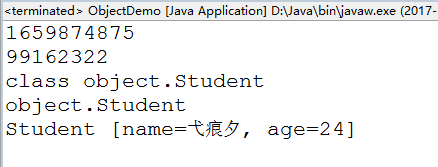
* x.equals(y)//返回值為boolean類型
“==”和equals()方法的區別?
“==”默認比較地址
equals()方法底層是通過“==”來實現的;默認比較的是兩個對象的地址值,如 重寫equals方法則比較的是兩個對象的內容是否相同
源碼:
public boolean equals(Object obj){
return(this==obj);
}
package object;
public class Student1 {
private String name;
private int age ;
public Student1() {
super();
}
public Student1(String name, int age) {
super();
this.name = name;
this.age = age;
}
public String getName() {
return name;
}
public void setName(String name) {
this.name = name;
}
public int getAge() {
return age;
}
public void setAge(int age) {
this.age = age;
}
//Shift+Alt+s——>h快捷鍵重寫equals()方法
@Override
public boolean equals(Object obj) {
if (this == obj)
return true;
if (obj == null)
return false;
if (getClass() != obj.getClass())
return false;
Student1 other = (Student1) obj;
if (age != other.age)
return false;
if (name == null) {
if (other.name != null)
return false;
} else if (!name.equals(other.name))
return false;
return true;
}
}
public class EqualsDemo {
public static void main(String[] args){
//創建兩個對象
Student1 st=new Student1("天凈沙",45);
Student1 st1=new Student1("天凈沙",45);
System.out.println(st==st1);//“==”默認比較的是兩個對象的地址:false
Student1 st2=st;//將st指向的地址值賦給st2;所以st與st2指向同一個地址
System.out.println(st==st2);
//System.out.println(st.equals(st1));底層是由"=="實現,不重寫則等價於“==”:false
System.out.println(st.equals(st1));//重寫後默認this.變量:表示當下傳入的值所以返回true
}
}//運行結果
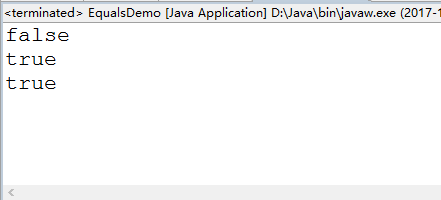
* protected void finalize()throws Throwable:當垃圾回收器確定不存在對該對象的 更多引用時,由對象的垃圾回收器調用此方法,但是,什麽時候調用垃圾回收器
不確定;
* protected Object clone()創建並返回此對象的一個副本
throws CloneNotSupportedException
註意事項:
Object 類的 clone 方法執行特定的復制操作。首先,如果此對象的類不能實現接 口 Cloneable,則會拋出 CloneNotSupportedException。
* Scanner類:
創建文本掃描器(鍵盤錄入)
Scanner sc=new Scanner(System.in);(創建錄入對象)
* 開發步驟:
創建錄入對象
錄入數據
輸出
* nextInt();錄入int類型
nextLine();錄入一個字符串類型
有時候錄入時會出現異常:java.util.InputMismatchException.(輸入和想得到的 數據類型不匹配)
* public static final InputStream in;(標準輸入流)
* public static final OutputStream out;(標準輸出流)
* hasNeatXX();在錄入之前,加上判斷功能,判斷是否有下一個可以錄入的XX類型的數 據
*Scanner類的註意事項:
先錄入int;類型數據在錄入String類型數據,第二次錄入沒有接收到,直接輸出了結果
這是因為再輸入一次後回車才能輸入第二次,由於第二次輸入的是字符串,回車會導致第
二次輸入失敗。
解決方案:
在第二次輸入前重新創建鍵盤錄入對象
package scanner;
import java.util.Scanner;
public class ScannerDemo {
public static void main(String[] args){
Scanner sc=new Scanner(System.in);
System.out.println("請輸入字符串:");
String str=sc.nextLine();//先錄入String後錄入int類型,沒有問題
System.out.println("請輸入整形數:");
int num=sc.nextInt();
System.out.println(str+"---"+num);
System.out.println("----------------");
System.out.println("請輸入整形數:");
int num1=sc.nextInt();
System.out.println("請輸入第二個整形數:");
int num2=sc.nextInt();
System.out.println(num1+"---"+num2);
System.out.println("----------------");
System.out.println("請輸入整形數:");
int num3=sc.nextInt();//先錄入int後錄入String,由於回車才能接收數據的原因直接輸出int類型的值
System.out.println("請輸入字符串:");
String str1=sc.nextLine();
System.out.println(num3+"---"+str1);
System.out.println("----------------");
System.out.println("請輸入字符串:");
String str2=sc.nextLine();//正常輸入
System.out.println("請輸入第二個字符串:");
String str3=sc.nextLine();//正常輸入
System.out.println(str2+"---"+str3);
System.out.println("----------------");
//上述問題的解決方法
System.out.println("請輸入整形數:");
int num4=sc.nextInt();
System.out.println("請輸入字符串:");
Scanner sc1=new Scanner(System.in);
String str4=sc1.nextLine();
System.out.println(num4+"---"+str4);
System.out.println("----------------");
}
}
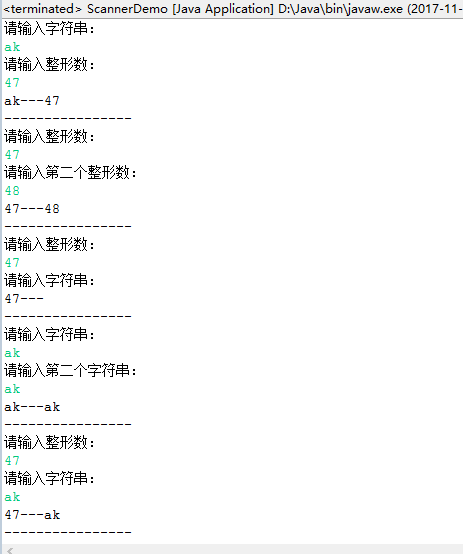
*String類型:
字符串類:所有的字符串字面值(如“abc”“[”……)都作為此類的實例實現
字符串為常量,創建後其值不可以改變。
package string;
public class StringDemo {
public static void main(String[] args) {
//定義一個字符串常量(在字符串常量池中如果有這個字符串則給出它的地址
//如果沒有,就重新定義一個字符串,並給出它的地址)
String s = "hello" ;
change(s) ;
//輸出字符串變量
System.out.println("s:"+s);
s += "world" ;
//s=“helloword”;並沒有改變常量池中的“hello”,是在常量池中重新開辟
//了空間存新的放字符串“helloword”,並將他的地址賦給s;
System.out.println("s:"+s);//輸出s為helloword
}
public static void change(String s) {
//String類型作為形式參數和基本數據類型的效果一樣,無論對形參進行什
//麽樣的操作都不會對實參產生影響
s += "javase" ;
}
}
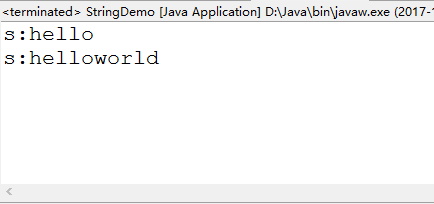
*String類常用的構造方法:
public String():表示一個空字符序列。
public String(byte[] bytes,Charset ch):默認字符集(編碼格式):GBK,如果是GBK 格式,可以不寫第二個參數
public String(byte[] bytes,int index,int length):將部分字節數組構造成一個 字符串
public String(char[] value):將字符數組構造成一個字符串
public String(char[] value,int index,int length):將部分的字符數組構造成一 個字符串
public String(String original):通過字符串常量構造一個字符串對象
獲取字符串的長度功能: public int length()
*面試題:
*數組中有沒有length()有length屬性,(字符串緩沖區:StringBuffer)中沒有 length(),字符串中有length()
*String s="hello";和String s=new String("hello");兩個有什麽區別?分別創建了幾 個對象?
第一個創建了一個對象
第二個創建了兩個對象(堆內存中有new String(),然後字符串常量池中會有一個字符 串常量"hello")
* String類的轉換功能(重點)
*byte[] getBytes():將字符串轉換字節數組
* 編碼和解碼:一定要保證編碼格式一致
編碼:
把能看懂的東西轉換成一個看不懂的東西:
String----->byte[]:public byte[] getBytes(String charsetName)
解碼:
把當前的byte[]轉成能看懂的東西(String):
byte[]----->String:public String(byte[] bytes,CharsetName ch)
package string;
import java.io.UnsupportedEncodingException;
import java.util.Arrays;
public class StringDemo3 {
public static void main(String[] args) throws UnsupportedEncodingException{
//創建String對象空參
String str=new String();
//獲得Str的長度並輸出
System.out.println("str.length():"+str.length());
System.out.println("str:"+str);
System.out.println("----------------");
//創建對象並初始化
String str1=new String("hello");
System.out.println("str1.length():"+str1.length());
System.out.println("str1:"+str1);
//定義數組
byte[] bt={65,66,67,68,69,70,};
String str2=new String(bt);
System.out.println("str2:"+str2);
System.out.println("str2.length()"+str2.length());
System.out.println("-------------------");
String str3="明天有雨";
byte[] bt2=str3.getBytes("utf-8");
byte[] bt3=str3.getBytes();
//編碼
System.out.println(bt2);//輸出一個地址值,原因是沒有重toString方法
//Arrays.toString();將變量轉化成字符串形式;源代碼重寫了toString();輸出bt2的內容
System.out.println(Arrays.toString(bt2));
System.out.println(Arrays.toString(bt3));
System.out.println("-------------------");
//解碼
String str4= new String(bt2) ;//編碼格式不匹配;輸出亂碼
System.out.println("str4:"+str4);
String str5=new String(bt2,"utf-8");//使用“utf-8”格式編碼後面解碼也必須用“utf-8”格式
System.out.println("str5:"+str5);
String str6=new String(bt3);//如果使用“GBK”格式編碼,則不需要寫明第二個參數,它是默認的
System.out.println("str6:"+str6);
}
}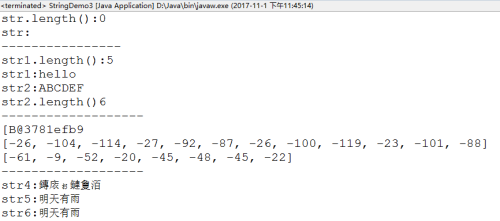
*char[] toCharArray():將字符串轉換成 字符數組 (開發中經常使用)
*static String valueOf(char[] chs):將字符數組轉換成字符串
*static String valueOf(int i):將一個int類型的數據轉換成字符串
註意:
String類中的valueOf()可以將任何數據類型轉換成字符串
*String toLowerCase():將字符串全部轉成小寫
*String toUpperCase():將字符串全部轉換成大寫
*String concat(String str):字符串拼接方法
package string;
public class StringDemo4 {
public static void main(String[] args){
//定義一個字符串
String str="Helloword";
System.out.println(str);
//將字符串轉換成 字符數組
char []ch=str.toCharArray();
//遍歷數組
for(int i=0;i<ch.length;i++){
System.out.print(ch[i]+" ");
}
System.out.println("");
System.out.println("---------------");
//將字符數字轉換成字符串
String str1=String.valueOf(ch);
System.out.println(str1+" ");
//將int類型數據轉換成字符串
String str2=String.valueOf(50);
System.out.println(str2);
//將字符串全部轉換成大寫
System.out.println("toUpperCase:"+str.toUpperCase());
//將字符串全部轉換成小寫
System.out.println("toLowerCase:"+str.toLowerCase());
//字符串的拼接
String str3="---javase";
System.out.println(str.concat(str3));
}
}
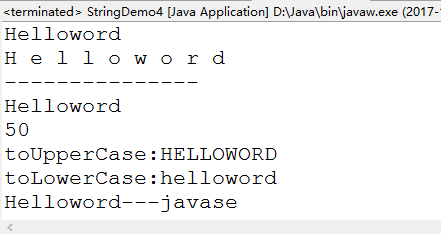
方法遞歸:方法調用本身的一種現象
三個條件:
1)需要定義個方法
2)方法必須有出口條件
3)必須有某一種規律
package homework;
public class FactorialDemo {
public static void main(String[] args){
int num=10;
System.out.println("10!="+getSum(num));
}
public static int getSum(int num){
// 1!=1 2!=1*2 3!=2!*3 4!=3!*4 5!=4!*5
//基數從一開始
int factorial=1;
//求階乘的和
for(int i=1;i<=num;i++)
{
//求階乘
factorial*=i;
}
return factorial;
}
}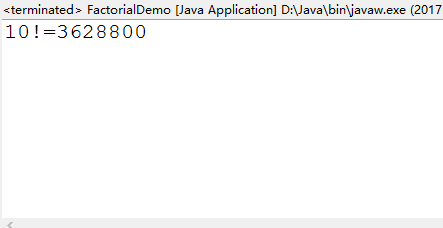
Java學習lesson 10
